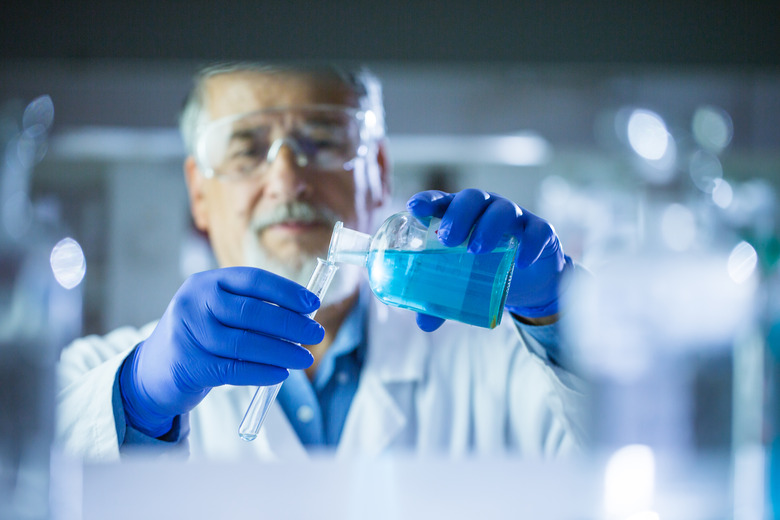How Does Paper Chromatography Work & Why Do Pigments Separate At Different Points?
Paper chromatography is used to separate liquids or gases into different components. The chromatography process has two different phases: a stationary stage and a liquid phase. Paper chromatography is part of the stationary phase. In paper chromatography, you use special absorbent paper to test the elements of a mixture to help determine its purity. You need very few materials to do paper chromatography experiments, making it a viable option for lab projects in schools.
Making a Paper Chromatograph
Making a Paper Chromatograph
You can make a paper chromatograph at home in order to test the components of ink and to better understand how paper chromatography works. To get started, buy chromatography paper, which is generally a part of science kits. Then, make three different plots of ink using three different pens. Number your plots of ink, and put the paper with the ink blots into a cup. Add solvent from your kit until it has reached the top of the paper, and cover the container so that the paper and the air in the cup are saturated with solvent.
Reading the Results
Reading the Results
As the paper absorbs the solvent, the different components of the ink in the pen react differently to it. These different spots of ink will separate out, allowing you to see exactly what the components of the ink colors were. You can then use the pen to draw a picture to try to notice the different colored dyes that you identified in the chromatography.
Pigment Separation
Pigment Separation
The pen experiment is helpful in understanding how paper chromatography works, because you can see how pigments of ink separate. Whenever you do a chromatography experiment, the purpose is to separate the parts of a whole out; in this case, the whole was the pen dot and you were separating out the ink. This works because certain pigments have a harder time being moved along the chromatography paper by solvents than others do. When a pigment is made up of larger molecules, it will not react with the solvent as much to move up the paper — resulting in it appearing lower on the paper than other pigments with smaller molecules. In the pen experiment and in other paper chromatography experiments, the process works because of this phenomenon of pigments traveling at different speeds.
Special Cases
Special Cases
Usually, if two identical spots on the chromatography paper where the ink or pigments have spread out are at the exact same distance, then that means two pigments were the same in the substance being tested. However, some limited exceptions exist. Some pigments and compounds will not be visible on their own in chromatography experiments unless you mix them with food coloring or dye. For example, when some amino acids mix together, they will not be visibly separated by using chromatography paper. However, you can mix food coloring and dye in, which would enable you to use a chromatograph to see the different amino acids once they separate.
References
Cite This Article
MLA
Writing, Alexis. "How Does Paper Chromatography Work & Why Do Pigments Separate At Different Points?" sciencing.com, https://www.sciencing.com/how-does-paper-chromatography-work-and-why-do-pigments-separate-at-different-points-12750741/. 22 August 2011.
APA
Writing, Alexis. (2011, August 22). How Does Paper Chromatography Work & Why Do Pigments Separate At Different Points?. sciencing.com. Retrieved from https://www.sciencing.com/how-does-paper-chromatography-work-and-why-do-pigments-separate-at-different-points-12750741/
Chicago
Writing, Alexis. How Does Paper Chromatography Work & Why Do Pigments Separate At Different Points? last modified March 24, 2022. https://www.sciencing.com/how-does-paper-chromatography-work-and-why-do-pigments-separate-at-different-points-12750741/
